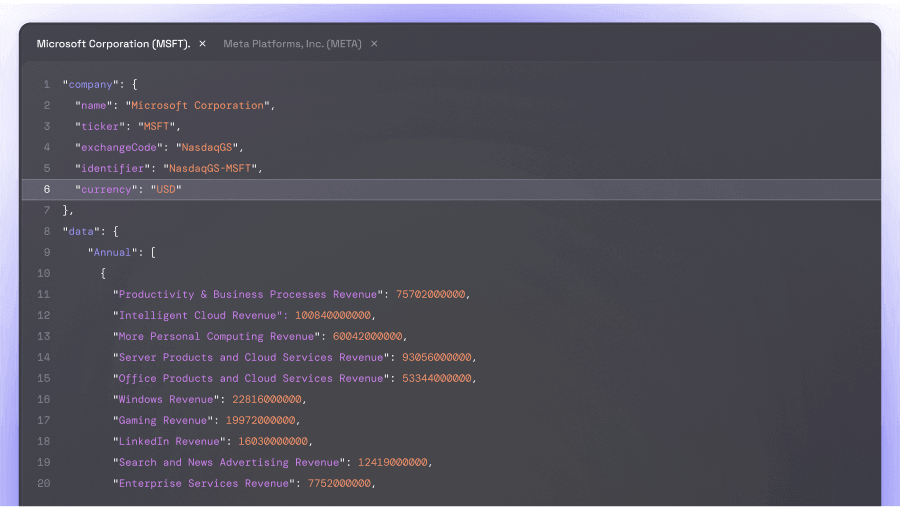Stock Index: S&P 500 Stocks
Eulerpool has compiled a list of stocks in the S&P 500 index for you. The characteristics and structure of this index will be explained below.
The Modern Financial Terminal
Trusted by leading companies and financial institutions
Stocks in the S&P 500
General Information
The Top 500 of the USA. The S&P 500 (Standard & Poor's 500, SPX) comprises the 500 largest US companies by market capitalization. The index is one of the three major US indices and provides a good indicator of how the companies and the economy are performing in the US.
Due to its international reputation, many people from all over the world look at the development of the S&P 500 every day, as U.S. stocks often provide strong impetus for how stocks in other countries are performing.
Master Data
| Country | USA |
|---|---|
| Stock Exchange | New York Stock Exchange |
| ISIN | US78378X1072 |
| ISIN Anzeigen Kurs Tageshoch Tagestief Vortag Eröffnung 52 W. Tief 52 W. Hoch Volumen Marktkapitalisierung Dividendenrendite Geschäftsjahr KGV KBV KCV KUV AlleAktien Fair Value | A0AET0 |
| Bloomberg Code | SPX |
| Category | Stock index |
| e: "AlleAktien" or "Fair Value" remains the same in English as well. Please do not translate these words. | Price index |
Calculation of the index
Unlike the Dow Jones or DAX, the S&P 500 is calculated as a price index and therefore does not include dividend payments. Stock splits also do not have a distorting effect on the price movement. The calculation is based on the so-called value index formula. The performance of each individual stock is taken into account in this calculation. However, larger companies have more influence on the movement than smaller companies.
The calculation of the index is updated every second, at least during the trading hours of the New York Stock Exchange. It is open from 15:30 to 22:00 German time. Additionally, the S&P500 serves as the basis for the CBOE Volatility Index.
The largest positions in the S&P 500
The Top 500 of the USA. The S&P500 was created by Standard & Poor's and includes the 500 largest companies in the country by market capitalization. However, there are certain inclusion criteria that must be met in order for a company to be listed in the S&P 500. Merely having a high market capitalization is not sufficient.
Overview of the index history
Merger. In 1923, an index with 233 values was published by Standard Statistics, which was continuously developed until the merger in 1941. Standard Statistics and Poor's Publishing merged, and the S&P 500 was issued on March 4, 1957. The performance was backdated to 1928 with daily prices, to 1918 with weekly prices, and to 1789 with monthly prices.
The base years are 1941 to 1943 with a value of ten index points. Since then, the index has achieved many milestones. On March 24, 1995, it reached 500 points for the first time, and on February 2, 1998, it reached 1,000 points.
The best and worst days of the S&P 500
The best day by far was March 15, 1933. On this day, the S&P 500 gained 16.6%, but this was due to the long trading halt. Since March 3, 1933, the stock exchanges had been closed due to the inauguration of Franklin D. Roosevelt. Places 2 to 4 were in the years 1929 to 1932. On October 13, 2008, there was an increase of 11.5% in the S&P 500, which occurred during the financial crisis.
The worst day was October 19, 1987, better known as Black Monday, with a drop of 20.4% in stock prices. The stock market crash was almost unexpected, as there had been a continuous upward trend for many years. The subsequent entries deal with the period leading up to the Great Depression of 1929, with drops in stock prices ranging from 9 to 12%.
Historical Price Development
Safe market. The US stock market has always been considered the most solid and successful market for investors around the world. Value stocks in the health, industry, or consumer sectors have been able to achieve top returns over long periods of time. The technology sector has served as a major driver of growth in recent years.
Significance for private investors
The best from the USA. The S&P 500 has always delivered good returns since its inception, especially for long-term investors. This index provides a good balance between the Dow Jones and the Nasdaq 100. The Dow Jones primarily consists of value stocks and is therefore less volatile than the Nasdaq 100, which mainly lists growth companies. The S&P 500 combines both, which is also reflected in its returns.

